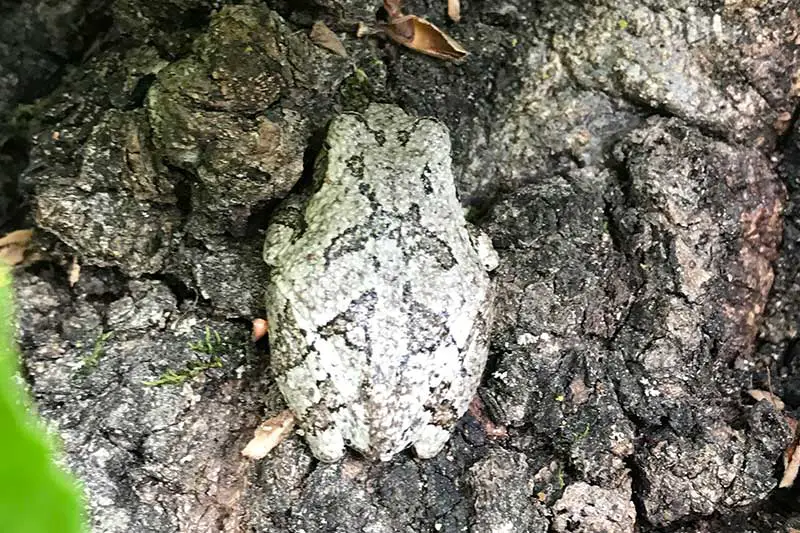Are there tree frogs in Missouri? You bet there are. At least 26 species of frogs and toads call the state home. At least 10 of those amphibians are in the tree frog family.
By definition, a tree frog is any frog species that spends the majority of its lifespan in an arboreal state. What that means is that they live primarily in trees or other vegetation that is high-growing. These frogs typically only descend to the ground to mate or spawn, where some species build foam nests on leaves. As adults, tree frogs rarely leave their arboreal habitat.
Now let’s explore pictures and learn some interesting facts about the frogs of Missouri, including those delightful tree frogs that add to the rich amphibian diversity of the state.
Types of tree frogs in Missouri
The 10 species of tree frogs you’ll come across in Missouri are the spring peeper, gray tree frog, Cope’s gray tree frog, green tree frog, bird-voiced treefrog, boreal chorus frog, Illinois chorus frog, upland chorus frog, northern cricket frog, and the western chorus frog.
1. Northern Spring Peeper

Scientific name: Pseudacris crucifer
Spring peepers derive their name from the chirping calls you can hear them making at the beginning of spring every year. In Missouri the spring peeper can be found in forests, woodlands, swamps, ponds, and marshes throughout most of the state.
Small chorus frogs, these tiny frogs are only 1.5 inches (3.8 centimeters) and weigh less than five grams. Their colors range from brown to tan, although it’s not uncommon to see some that look gray or olive green. Spring peepers have a dark cross on the back.
In the freezing winters, these frogs hibernate behind bark and under logs.
2. Gray Tree Frog

Scientific name: Dryophytes versicolor
Gray tree frogs are small frogs found throughout Missouri that can change their color from green to gray as needed for camouflage. Here’s a fun fact about gray tree frogs. Their color changes to match whatever surface they’re sitting on. Moreover, their mottling can vary from almost pure white to nearly black.
If you see gray tree frogs in an area that isn’t their normal habitat, they will be mostly gray in color. Their legs are patterned with dark bands.
These tree frogs live in forested areas and only descend to the ground to mate. It’s not unusual to see them around windows and porch lights where they can feast on insects.
3. Cope’s Gray Tree Frog
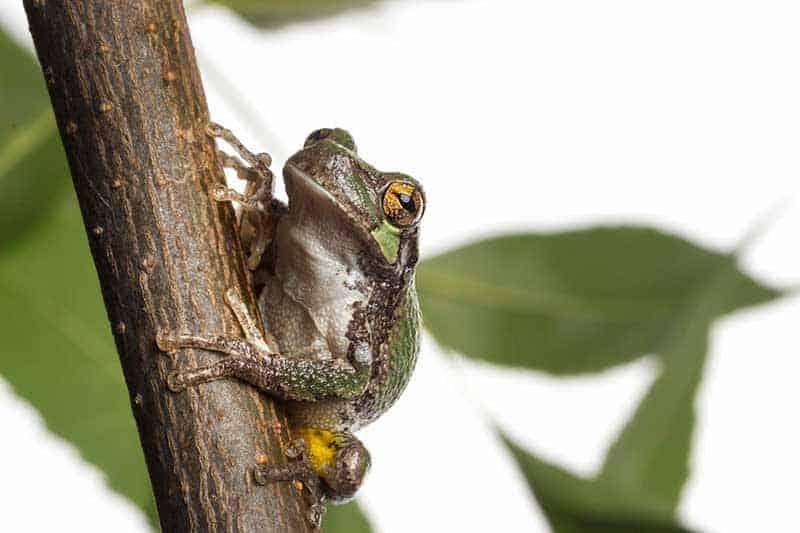
Scientific name: Dryophytes chrysoscelis
Frequently referred to as the Southern gray tree frog, Cope’s gray tree frogs share the much of the same geographical area in Missouri as the gray tree frog and look identical to them. What differentiates the Cope’s gray tree frog is its higher-pitched and faster-paced call and this is the only difference between the two species.
In terms of habitat, the Cope’s gray tree frog lives in woodland areas and they move to ponds for breeding.
These frogs are primarily solitary frogs, but they do form choruses that allow them to call when they’re together. You can sometimes even hear these frogs responding to loud noises during the day.
4. Green Tree frog

Scientific name: Hyla cinerea
The green tree frog, one of Missouri’s tree frogs, possesses a slender, smooth body that is bright to dark green or grayish, with sides usually marked by a white stripe featuring a crisp black border. Adults grow to a size of 1 to 2.5 inches in length. Most adults have a few orange or yellow spots on their backs.
During the day they hide in shady areas or under vegetation surrounding water. At night they come out to catch flying insects. The green tree frog call, heard from April to September, is a nasal quoonk-quoonk repeated up to 75 times per minute.
Green tree frogs occur mainly in southeastern Missouri.
5. Upland Chorus Frog

Scientific name: Pseudacris feriarum
The upland chorus frog can be found in the eastern and southern U.S. Human activity doesn’t seem to scare them much, and they will inhabit small neighborhood ponds, flooded fields or roadside ditches. They like a moist, vegetated habitat near water, but spend very little time in the water itself. You will likely only see and hear them when breeding, and their most active breeding season is November through March.
Their skin can appear various shades of brown, with a dark brown stripe running along their side. Their throat and chest are often a light cream color. The repetitive call of these frogs is sometimes described as sounding like running a finger along the teeth of a plastic comb.
In Missouri the upland chorus frog is widespread throughout the state.
6. Northern Cricket Frog
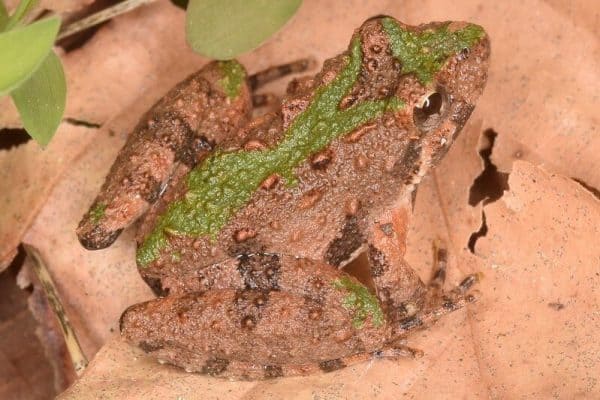
Scientific name: Acris crepitans
Northern cricket frogs have long back legs, a pointed snout and slightly warty skin. Their color can vary from green to brown and brownish red. They have a stripe (color varies) that extends between the tops of their eyes and a “Y” shaped stripe on their back. The northern variety has more webbing on their back toes and the dark stripe on their thigh has ragged edges.
Cricket frogs are active both day and night and like pond, marsh, stream and river habitats where they will live in the vegetation along the shore. They lay single or small groups of eggs, and the tadpoles have a black tip on their tail. Northern cricket frogs will call from April to August.
Northern cricket frogs are found throughout Missouri.
7. Bird-Voiced Tree Frog
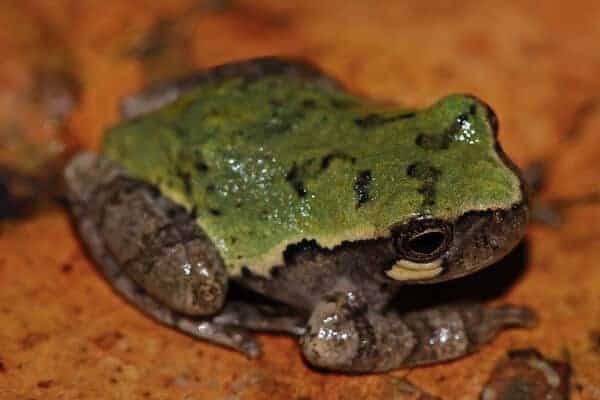
Scientific name: Hyla avivoca avivoca
The bird-voiced tree frog is typically 1 to 1.75 inches in length and is green, brown, or gray with dark blotches. They have a light spot under each eye which can vary in color. They spend most of their time in trees, only coming down to breed in shallow pools of swamps and creeks.
Their main diet is spiders and tree dwelling insects. The unusual name refers to their call, which is described as a birdlike whistle. You can hear them between April and September. In Missouri, these little frogs only occur in extreme southeastern parts of the state.
8. Boreal chorus frog

Scientific name: Pseudacris triseriata maculata
The boreal chorus frog is a subspecies of the western chorus frog, which we’ll see next. According to mo.gov these tiny frogs occur pretty much statewide in Missouri.
Boreal chorus frogs are brown, reddish, tan, gray or olive in color with 3 dark stripes along their backs. They’re about 1.5 inches in length as adults and their range does overlap with the western chorus frog in some places. The boreal variant is much more common in Canada than it’s cousin.
9. Western chorus frog
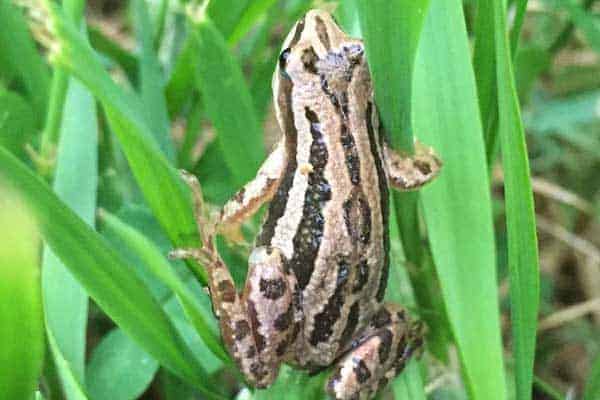
Scientific name: Pseudacris triseriata
The western chorus frog is a common tree frog in Missouri and common throughout most areas of the state. They’re found throughout much of the midwest and eastern United States. South of Arkansas, Illinois, and Indiana, you’ll find the upland chorus frog.
Western chorus frogs are probably the smallest tree frogs in Missouri, and one of the smallest in the country. As adults they are sometimes less than an inch in length. They prefer living near wooded areas, ponds, marshes, wetlands, or slow moving bodies of water.
The color varies and may be anywhere from greenish gray to brown. You can identify them by the 3 dark stripes going down their backs and their small size. They are very difficult to distinguish from boreal frog that’s up next. Though it’s believed that the western variety has longer legs.
10. Illinois chorus frog
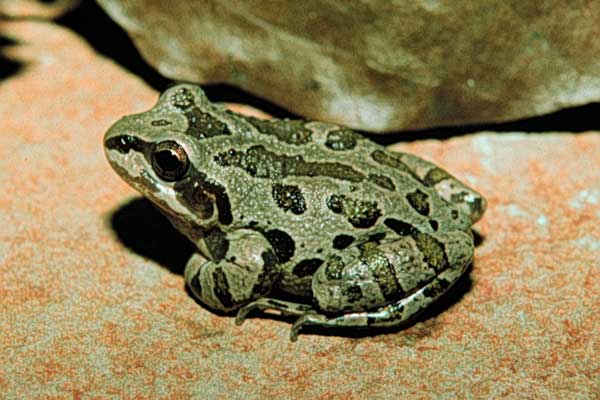
Last up on this list of tree frogs in Missouri is the Illinois chorus frog. They only have a very limited range in a small portion of southeastern Missouri as well as central Illinois.
This little chorus frog can reach about 1.5 inches in length and adults are normally tan-gray in color. Illinois chorus frogs can be identified by a small diamond or triangle shaped pattern between their eyes.
You may also like: Do tree frogs make good pets?
